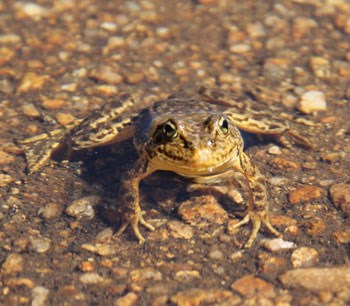|
High elevation aquatic resources in Yosemite National Park include the lakes, ponds, wet meadows, and streams located in the high country above Yosemite Valley and the diverse and vibrant plant and animal communities—including amphibians--that they support. 
The impacts of non-native fish on high elevation aquatic and adjacent terrestrial ecosystems are well documented and occur at all levels of the food web. Non-native fish feed on aquatic insects as well as frogs. Fish also compete for food with frogs, snakes, and bats and some birds, several of which feed on the adult stage of the aquatic insects. Predation and competition by nonnative fish decreases populations of many of these animals, most notably the Sierra Nevada yellow-legged frog, a federally endangered species that has declined from over 95% of their historic range. The Sierra Nevada yellow-legged frog was once the most abundant amphibian found in these high-elevation aquatic systems. Visitors would often see hundreds of frogs during walks along mountain lake shores and thousands of tadpoles could also be seen piled on top of each other. Frogs were a vital link in the food chain—they were predators feeding primarily on insects and they were important prey for native birds, snakes, and mammals when still numerous. The emergence of insects from the aquatic environment is another vital link in the food chain providing an irreplaceable food source for birds and bats and their young. As early as the 1920s, negative impacts of non-native fish on frogs were documented in prominent natural history texts. One naturalist stated:“…frogs, in tadpole form at least, do not occur in lakes which are stocked with trout… the advent of fish in a lake sooner or later nearly or quite eliminates the frogs. It seems probable that the fish prey upon the tadpoles, so that few or none of the latter are able to reach the stage at which they transform.” - Animal Life in the Yosemite by J. Grinnell and T. I. Storer, 1924 
The Sierra Nevada yellow-legged frog needs fish-free habitat now more than ever. Their depleted and isolated populations have been devastated by a newly discovered fungal disease, chytridiomycosis or “Chytrid” caused by the fungus Batrachochytrium dendrobatidis. Chytrid has been spreading across the Sierra Nevada since the 1970s causing extinctions of hundreds of frog populations. The fungus has infected most Sierra Nevada yellow-legged frog populations in Yosemite National Park, however there are a few populations that appear to be adapting to the fatal effects of the fungus and persisting even when infected. Creating habitat for the persisting populations of Sierra Nevada yellow-legged frog by removing fish is critical for the recovery of this endangered amphibian.
Yosemite has an ongoing lake restoration project to restore fishless ecological conditions to about 10% of the remote lakes in Yosemite (approximately 25 out of an estimated 250 lakes that contain fish in the park). Restoration includes the removal of fish to create habitat for the critically endangered yellow-legged frog as well as other aquatic species. By restoring fishless conditions to these lakes, the park has increased the population of the Sierra Nevada yellow-legged frog while still providing high-quality fishing experience to visitors who value this activity in the numerous sites throughout the park where fish are not being removed. More Information
References
|
Last updated: September 23, 2025
